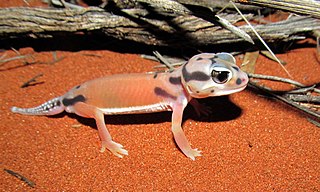
Gecko is a browser engine developed by Mozilla. It is used in the Firefox browser, the Thunderbird email client, and many other projects.

Gekkonidae is the largest family of geckos, containing over 950 described species in 61 genera. Many "typical" geckos are members of Gekkonidae, including house geckos (Hemidactylus), tokay geckos, and day geckos (Phelsuma). Gekkonid geckos occur globally and are particularly species-rich in tropical areas.

The genus Eublepharis, of which one known type is the leopard geckos, were first described by the British zoologist John Edward Gray in 1827. The etymology of their name is 'eu' = good (=true) |'blephar' = eyelid, and all have fully functional eyelids. Members of this genus are found in eastern and southwestern Asia where they are found in rocky grassland habitats. These geckos are sturdily built. Their tail is shorter than their snout-vent length and their body is covered with numerous wart-like bumps. The toes do not have adhesive lamellae or membrane. Eublepharis are crepuscular or nocturnal ground-dwellers. Included in this group is the popular pet gecko, especially in the west they were first brought to the US in the 1970s were zoo's started to breed them and there are nearly 3 million captive bred Leopard Geckos in the US: the leopard gecko. A common misconception about Leopard Geckos is that they live in bare, arid deserts, but they are from the rocky grasslands in southwestern Asia, including Northern Indian,Afghanistan and Pakistan. They avoid deserts and places with low water. They live close to the ground and are a non arboreal species, and they are night-active. Once they have breed the mates will leave each-other and usually will never see one another or their hatchlings.

Hemidactylus is a genus of the common gecko family, Gekkonidae. It has about 90 described species, newfound ones being described every few years. These geckos are found in all the tropical regions of the world, extending into the subtropical parts of Africa and Europe. They excel in colonizing oceanic islands by rafting on flotsam, and are for example found across most of Polynesia. In some archipelagoes, cryptic species complexes are found. Geckos like to live in and out of houses. They have been introduced to Australia.

The knob-tailed geckos or knob-tails, are a group of species of geckos, all found in the genus Nephrurus.

Underwoodisaurus is a small genus of Australian geckos, commonly known with the species Uvidicolus sphyrurus as thick-tailed geckos. The species Underwoodisaurus milii is often called the thick-tailed gecko.
Nephrurus deleani, also known commonly as the acacia knob-tailed gecko or the Pernatty knob-tailed gecko, is a species of gecko, a lizard in the family Carphodactylidae. The species is endemic to Australia.

Nephrurus amyae, also known as the centralian rough knob-tailed gecko, is a species of gecko. It is the largest gecko in the genus Nephrurus, and like all species of Nephrurus is endemic to Australia.

Kleptothermy is any form of thermoregulation by which an animal shares in the metabolic thermogenesis of another animal. It may or may not be reciprocal, and occurs in both endotherms and ectotherms. Its most common form is huddling.
Nephrurus stellatus, also known as the stellate knob-tailed gecko, starry knob-tailed gecko, or southern knob-tailed gecko, is a species of gecko in the family Carphodactylidae. It is endemic to southern Australia.

The Carphodactylidae are a family of geckos consisting of 30 described species. All species occur in Australia.
Lucasium byrnei, commonly known as the gibber gecko or Byrne's gecko, is a species of small, nocturnal gecko, a lizard in the family Diplodactylidae. The species is endemic to Australia.
Nephrurus asper, also known as rough knob-tailed gecko or spiny knob-tailed gecko is a species of gecko. Like all species of Nephrurus is endemic to Australia.

Nephrurus laevissimus, also known as the smooth knob-tailed gecko , is a species of gecko. Like all species of Nephrurus, it is endemic to Australia.
Nephrurus sheai, also known as Kimberley rough knob-tailed gecko, is a species of gecko. Like all species of Nephrurus is endemic to Australia.
Nephrurus vertebralis, also known as midline knob-tailed gecko, is a species of gecko. Like all species of Nephrurus is endemic to Australia.
Nephrurus wheeleri, also known as banded knob-tailed gecko, is a species of gecko. Like all species of Nephrurus is endemic to Australia.

Pygopodoidea is a gecko superfamily and the only taxon in the gekkotan subclade Pygopodomorpha. The clade includes three Australasian families: Diplodactylidae, Carphodactylidae, and Pygopodidae. Traditional gekkotan systematics had considered Diplodactylidae and Carphodactylidae as subfamilies of the family Gekkonidae, but recent molecular work have placed Pygopodidae within Gekkonidae making it paraphyletic. These analyses have shown support of Pygopodidae and Carphodactylidae being sister taxa, with Diplodactylidae occupying a basal position in Pygopodoidea.









